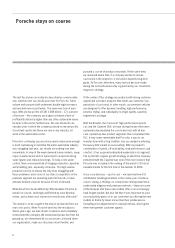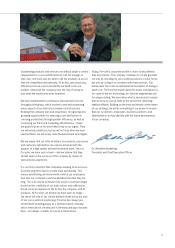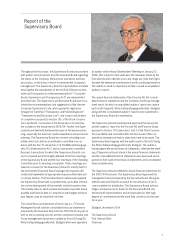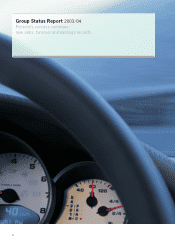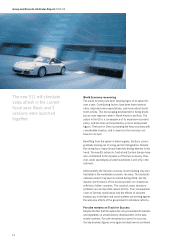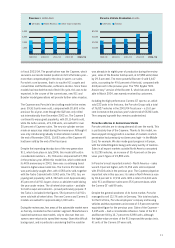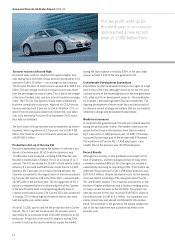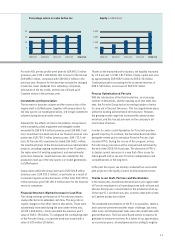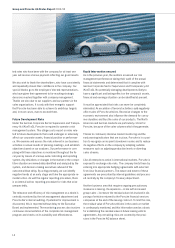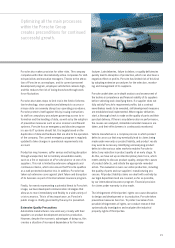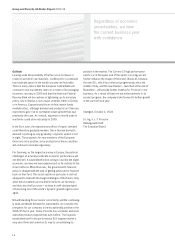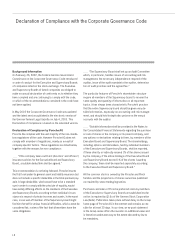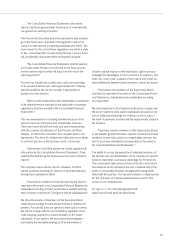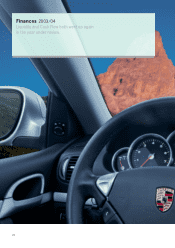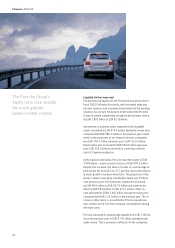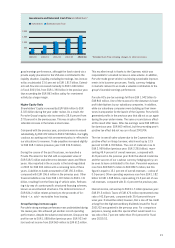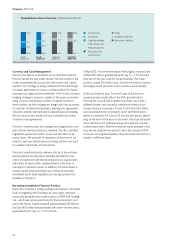Porsche 2003 Annual Report Download - page 18
Download and view the complete annual report
Please find page 18 of the 2003 Porsche annual report below. You can navigate through the pages in the report by either clicking on the pages listed below, or by using the keyword search tool below to find specific information within the annual report.
14
ted rates who have been with the company for at least one
year will receive a bonus payment reflecting our good results.
We also wish to thank the shareholders, who have consistently
and repeatedly shown their confidence in the company. Our
special thanks go to the employees’ elected representatives,
who have given their agreement to far-reaching strategic
decisions reached together with company management.
Thanks are also due to our suppliers and our partners in the
sales organizations. It is only with their energetic support
that Porsche has been able to achieve its ambitious targets
and, in most cases, even to exceed them.
Future Development Risks
Under the German Corporate Sector Supervision and Transpa-
rency Act (KonTraG), Porsche is required to operate a risk
management system. This obliges us to report on risks rela-
ted to future developments that could endanger or adversely
affect our corporate assets, financial position or performan-
ce. We examine and assess the risks inherent in our business
activities in annual rounds of planning meetings, and establish
objectives based on our analyses. Our performance in com-
plying with these objectives is monitored throughout the fis-
cal year by means of a Group-wide controlling and reporting
system. Any deviations or changes in the market or the compe-
titive situation are immediately identified and analyzed by the
system, and decision-making executives advised of the
outcome without delay. By acting promptly, we can identify
negative trends at an early stage and take the appropriate re-
medial action. As well the regular reporting procedure, there
is an internal ad-hoc reporting procedure for risks that arise
unexpectedly.
The relevance and efficiency of risk management as a whole is
centrally monitored by the risk management department and
Porsche AG’s internal auditing. If potential for improvement is
discovered, this is reported without delay to the Executive
Board and implemented. The monitoring process also involves
continuous documentation of the complete risk management
program and checks on its suitability and effectiveness.
Rapid Intervention ensured
As in the previous year, the auditors assessed our risk
management performance during their audit of the annual
financial statements and determined that it complies with
German Corporate Sector Supervision and Transparency Act
(KonTraG). No potentially damaging developments likely to
have a significant and lasting effect on the company’s assets,
financial and earnings situation can be identified at present.
It must be appreciated that risks can never be completely
eliminated. An escalation of terrorist activities could negatively
affect sales of Porsche vehicles. Recessive changes to the
economic environment also influence the demand for consu-
mer durables and thus the sales of our products. The North
American and German markets are particularly critical for
Porsche, because of the sales volumes which they generate.
Thanks to continued, intensive market monitoring and the
early warning indicators that are in place, Porsche is in a posi-
tion to recognize an incipient slowdown in sales and to reduce
its negative effects on the company by adopting suitable
measures such as adjusting production levels or diverting
sales streams.
Like all enterprises active in international markets, Porsche is
exposed to exchange rate risks. The company limits these by
entering into appropriate hedging agreements with selected
first-class financial partners. The nature and extent of these
agreements are prescribed by internal guidelines and process-
ed centrally by the company’s Treasury department.
Another business area that requires ongoing precautionary
measures is leasing. Its expansion – in line with increased
group sales – increases the residual value risk involved in dis-
posing of vehicles returned to the Porsche financial services
companies at the end of the leasing contract. To limit this risk,
the residual value of Porsche vehicles in the used car market
is continuously monitored, and this information used as a basis
for establishing the residual value in future leasing vehicle
agreements. Any remaining risks are covered by the provi-
sions in the Porsche AG balance sheet.
Group and Porsche AG Status Report 2003 ⁄ 04


